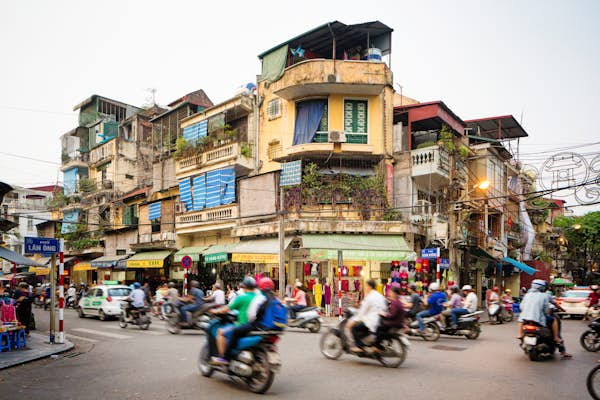
Scratching China’s back with its mountain-studded crown, Vietnam’s tall and slender body extends its toes all the way south to the tropical waters off Cambodia’s coast. From mega-cities to white-sand beaches, jade-green paddy fields and soaring limestone peaks, Vietnam offers a staggering pick of different adventures and landscapes. It’s hard to decide where to start.
Seek breathtaking outdoor experiences in diverse landscapes, sample delightfully sweet coffee and visit tranquil countryside rice terraces. These and more make up the highlights of a trip to Vietnam.
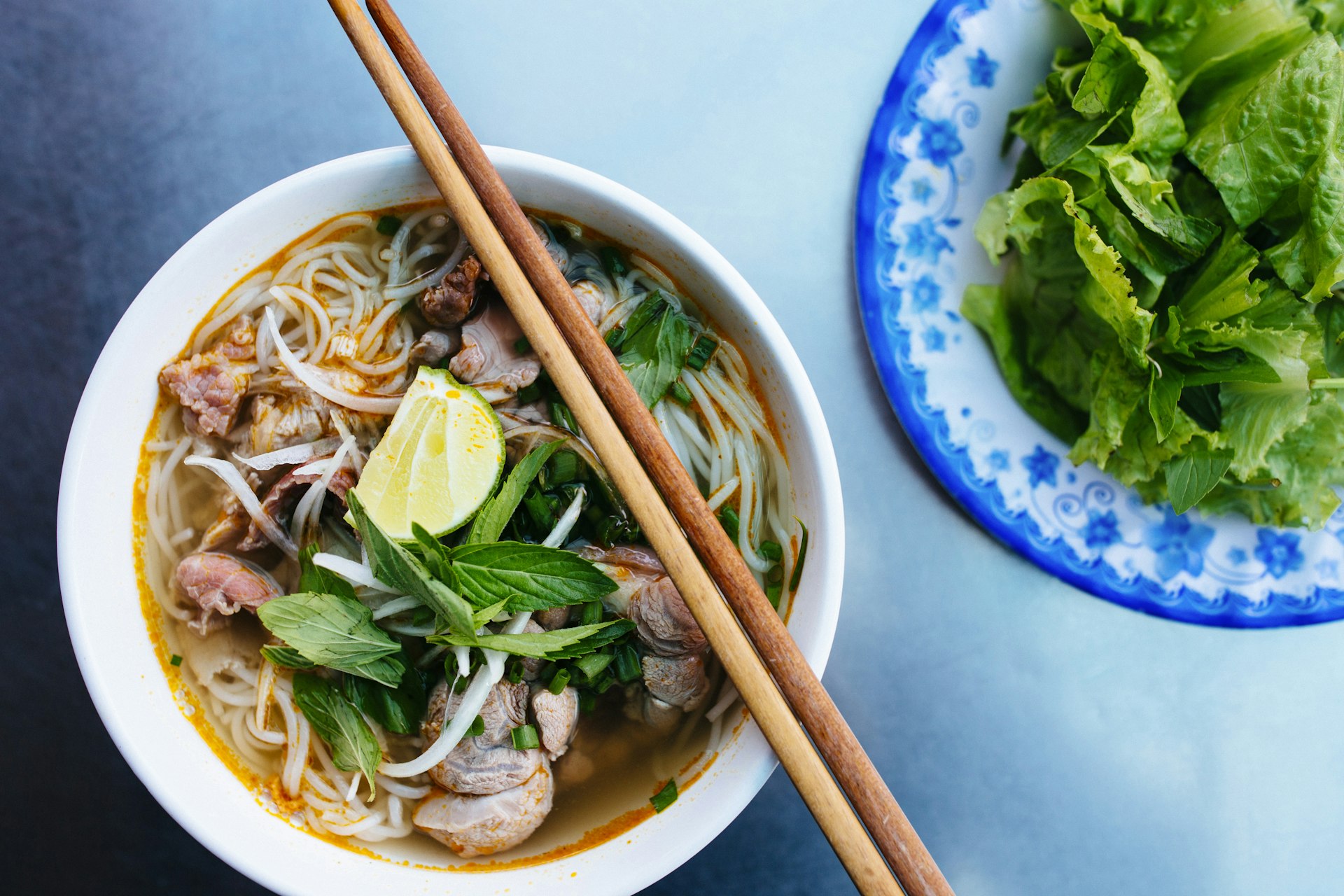 Vietnamese bún bò huế (beef noodle soup) is similar to phở, but the noodles are cylindrical like spaghetti © Mint Images / Getty Images
Vietnamese bún bò huế (beef noodle soup) is similar to phở, but the noodles are cylindrical like spaghetti © Mint Images / Getty Images
1. Taste the Old Empire’s food in Hue
Vietnam’s Nguyen Dynasty ruled in Hue until 1945. The imperial city wasn’t just the country’s seat of power but also the epicenter of its classic cuisine: of Vietnam’s estimated 3,000 dishes, some 1,700 originate in Hue. The Old Empire cuisine consisted of “imperial dishes” (ẩm thực cung đình) created within the Imperial City by an entourage of 50 royal chefs with ingredients sourced around the world and “royal dishes” (ẩm thực hoàng gia), or the most court-worthy “peasant food” found outside the citadel.
They were all painstakingly prepared and presented as choreographed banquets of up to 50 dishes to please all of the emperor’s senses. Some picks from that opulent royal menu are still served in some of Hue’s best restaurants, such as Cung Dinh, Thin Gia Vien and Hoang Phu. They offer striking, labor-intensive plates that give diners a veritable taste of Hue’s past imperial meals.
Explore the planet’s most surprising adventures with our weekly newsletter delivered to your inbox.
2. Spot rare monkeys in the Son Tra Peninsula
The red-shanked doucs of the Son Tra Nature Reserve, a mountainous peninsula overlooking the bay of Danang in central Vietnam, have stolen the show since American troops aptly named their haven “Monkey Mountain.” With golden-furred faces, red legs, glove-like white arms and long, ash-gray tails, Son Tra’s last 1300 doucs have become an unwilling attraction because of their rarity. Crowds of tourists flock to photograph them.
Planning tip: Absolutely refrain from feeding the wildlife to avoid disrupting their eating habits and the population’s health.
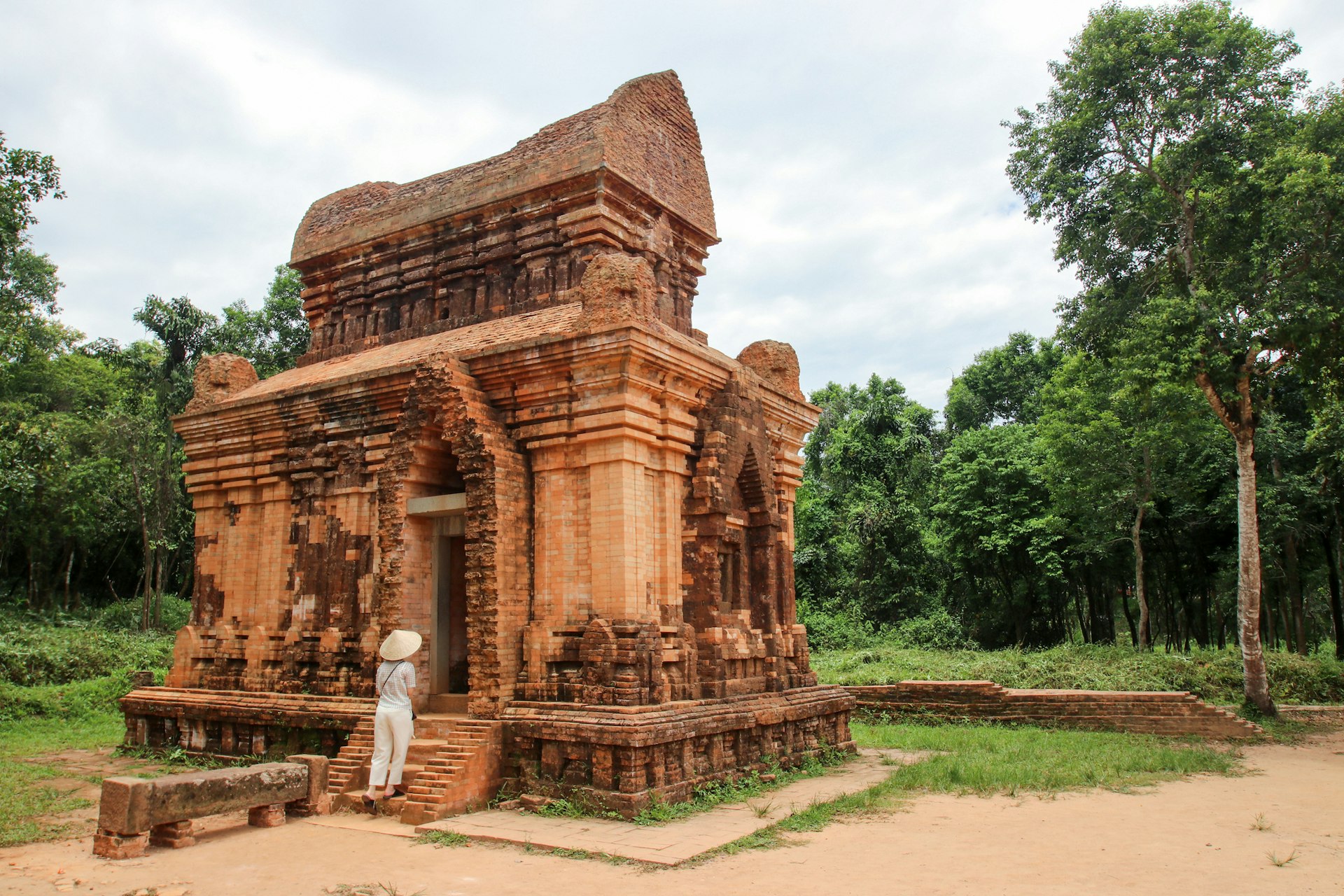 The over 70 temples and tombs at My Son (such as this former library) were built between the 4th and 14th centuries AD © Frans Sellies / Getty Images
The over 70 temples and tombs at My Son (such as this former library) were built between the 4th and 14th centuries AD © Frans Sellies / Getty Images
3. Marvel at historical Indian-Champa ruins in My Son
Many visit the Unesco-protected ancient town of Hoi An, but fewer venture inland to another Unesco delight – Mỹ Sơn, a cluster of Hindu temple ruins surrounded by jungle and a ring of mountains protecting the sacred Thu Bon river. Built between the 4th and 14th centuries by the Hindu kingdom of the Cham, the terracotta-hued brick tower temples of Mỹ Sơn testify to the original site of their religious and political capital. The ruins are open from 6am to 5pm, with sunrise tours departing from Hoi An increasingly popular.
Planning tip: Visit in the afternoon after 2pm for a more intimate experience.
4. Visit the Cao Dai Holy See in Tay Ninh
Come to grips with one of the world’s youngest religions in the southern Mekong Delta town of Tay Ninh, an easy day pilgrimage from Ho Chi Minh City. Founded by Ngô Văn Chiêu in 1926, Cao Dai is a monotheistic faith fusing principles of Buddhism, Taoism, Christianity, the occult and Islam, with the ultimate goal of freeing the soul from the endless cycle of reincarnation.
The Cao Dai Holy See may look like a European-styled church fronted by two bell towers from a distance. A closer look reveals turrets decorated with weapon-toting statues, an all-seeing eye, and even a Communist-looking red star – the sect worships, among others, Jesus Christ, Buddha, Mohammed and even French novelist Victor Hugo. Visitors can enter the shrine to witness prayers four times a day.
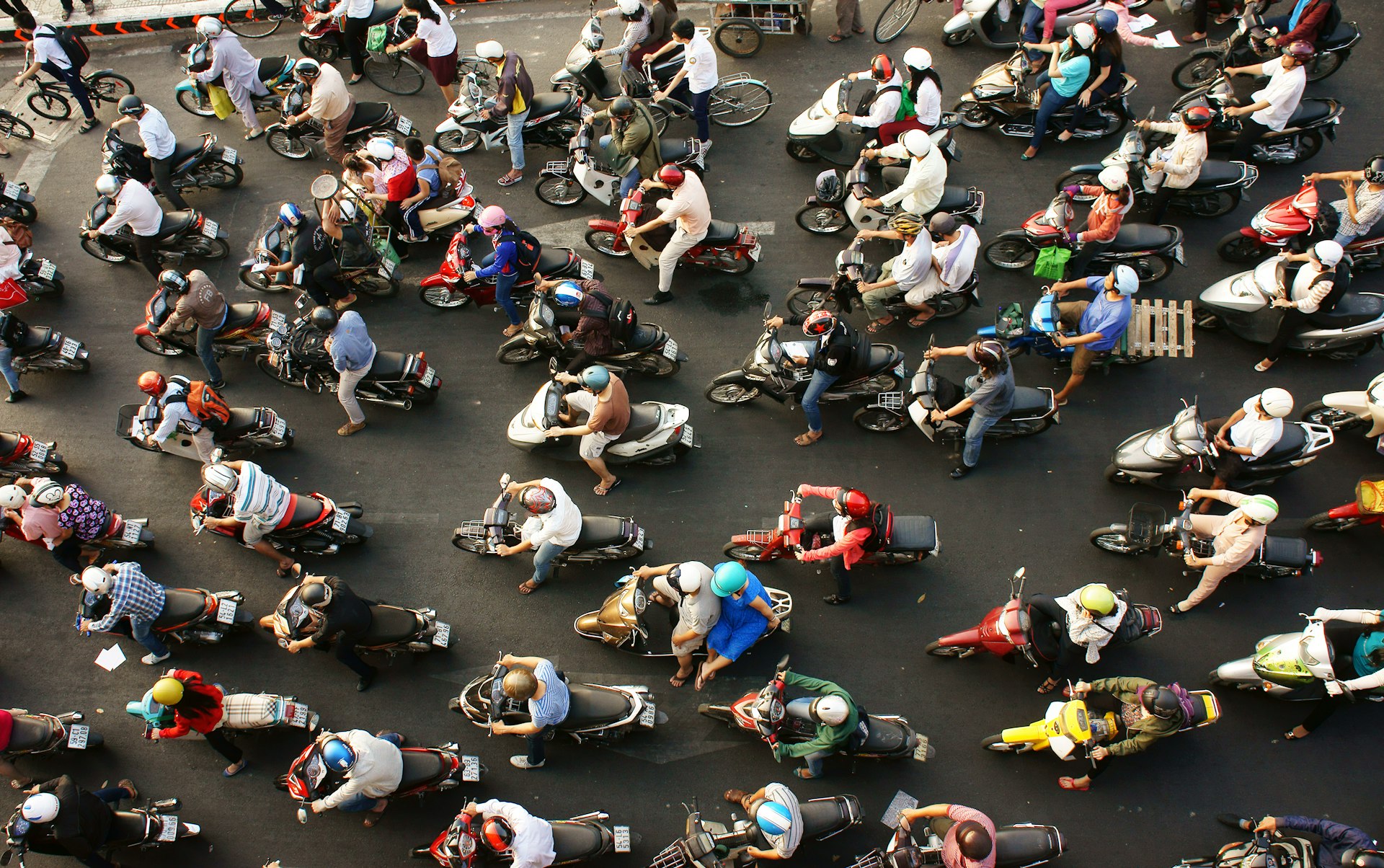 City traffic at rush hour in Vietnam, where the most popular mode of transport is by motorcycle © xuanhuongho / Shutterstock
City traffic at rush hour in Vietnam, where the most popular mode of transport is by motorcycle © xuanhuongho / Shutterstock
5. Jump on a motorbike and explore
Vietnam largely moves on two wheels, and even if it may take courage to adjust to the traffic, a motorbike offers total freedom to explore the country. Congestion thaws at the edge of any city, leaving the northern and central mountains, thousands of miles of coastline, and the green paddies of the Mekong Delta open to endless adventures. The large availability of motorbikes for rent means that planning short multi-day loops around most towns is as straightforward as planning multi-week cross-country journeys.
Planning tip: Be aware that international driving permits are becoming increasingly necessary, and your insurance may stipulate that you have a motorcycle license at home to be valid.
6. Face the twin Ban Gioc waterfalls as you peek into China
A staggering 208m (682ft) wide and 70m (229ft) tall, the breathtaking Ban Gioc Waterfalls on the Quay Son River mark the border between Cao Bang and China’s Guanxi provinces. They are the widest falls in all of Vietnam. Bamboo rafts on the two sides of this liquid border punt visitors to the base of the cascade for close-up views. While it’s possible to hike beyond the falls or up to a nearby hilltop temple, keen hikers will find the nearby Nguom Ngao caves and their kilometer-long walkway, flanked by an impressive number of well-lit stalactites, a more rewarding challenge.
Detour: Cao Bang, 90km (56 miles) away, is the springboard for an offbeat region filled with more caves, village homestay experiences and delicious local food.
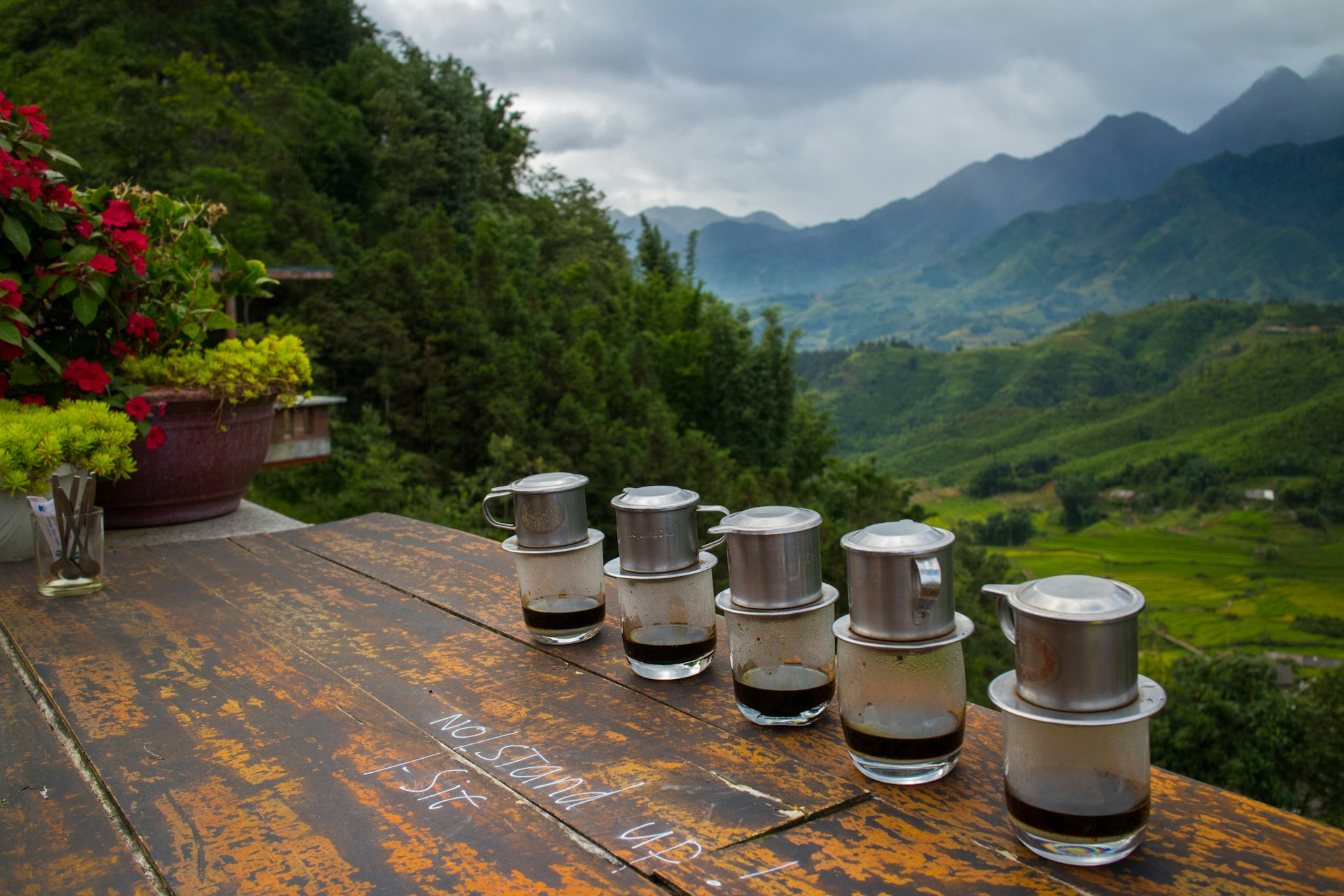 Vietnamese coffee is famously drunk very sweet; the coffee is filtered and mixed with sweetened condensed milk © nguyenkid / Shutterstock
Vietnamese coffee is famously drunk very sweet; the coffee is filtered and mixed with sweetened condensed milk © nguyenkid / Shutterstock
7. Have a taste of the “Asian Alps” in Sapa and Dalat
The former French Hill station of Sapa, northern Vietnam’s most popular gateway into China, is surrounded by mountains so impressive that the French colonizers called them the “Tonkinese Alps.” This is the realm of the H’Mong and Dao ethnic minorities, who farm terraced paddy fields wearing beautiful traditional attire still to this day.
Don’t think that only Vietnam’s northernmost reaches have mountains and cooler climates: 308km (191 miles) northeast of Ho Chi Minh City is Dalat, a former French colonial hill station dotted with hundreds of old-world European villas clustered around the whitewashed King Palace. One visitor favorite up here is Hang Nga Crazy House, an ever-changing avant-garde guesthouse created by artist Ms Dang Viet Nga. It mixes swirls of color, wavy structures, sculptural bedrooms and fairytale-like turrets into a building you’ve never imagined.
8. Visit Dak Lak’s coffee plantations
The Dak Lak province seals the southern end of Vietnam’s Central Highlands with endless undulating basaltic hills. At 1600m (5250ft), this is the perfect coffee-growing ground.
Coffeeholics should travel to the region’s capital of Buon Ma Thuot to tuck into the surrounding hills where dozens of different coffee strains, from Arabica to Liberica and Robusta, are grown by eco-sustainable farms.
Planning tip: The best time to visit is from September to the end of December, when the region is in full swing for the harvest season.
9. Enjoy the sea in tranquil Quy Nhon
The coastal town of Quy Nhon has somehow remained hidden behind the 10km (6-mile) stretch of land that separates it from ever-busy Highway 1. Its long, fine white beaches backed by mountains have earned Qui Nhon the name “Maldives of Vietnam.” Start in Quy Nhon beach, straight in town and lined with low-key bars, and then hop to the true local favorite, Ky Co beach, a less-developed arch of powdery white sand about 30 minutes drive out of town – visit early or late in the day after most of the domestic tourists have retired.
Detour: Just a few more minutes’ drive away is Eo Gio, a series of red rocky cliffs soaring right next to the blue sea. Nature lovers can try the walking path that snakes along the coastline or climb up the rocky hills for perfect views.
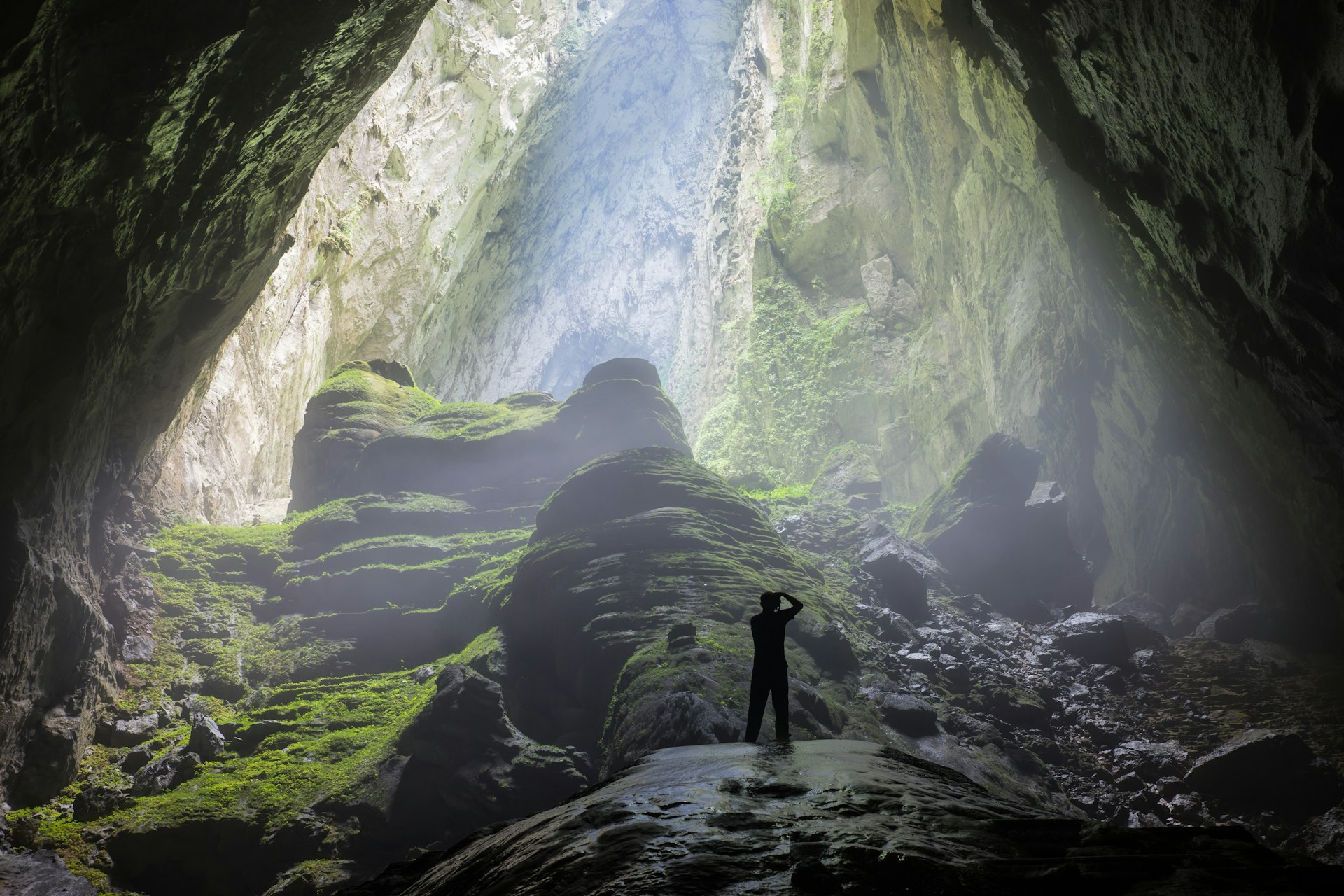 Hang Son Doong is the largest cave in the jungle-clad Phong Nha-Ke Bang National Park © Hanoi Photography / Shutterstock
Hang Son Doong is the largest cave in the jungle-clad Phong Nha-Ke Bang National Park © Hanoi Photography / Shutterstock
10. Brave the world’s largest cave in Phong Nha
The Phong Nha-Kẻ Bàng National Park in north central Vietnam’s jungle-covered Quang Binh province straddling the Laos border is filled with caves, including the world’s largest, Hang Son Doong. Its scale is mind-blowing: a mile in, and a 747 airplane could fly through the cave’s tunnel. Because parts of the limestone ceiling have collapsed and brought in sunlight, Hang Son Doong contains an entire rainforest ecosystem with trees as tall as buildings.
Flying foxes, rare langurs, and even a small population of tigers dwell in this unique underworld. What could be the world’s biggest stalagmite, the 200ft-tall “Hand of Dog,” is also found here. Since 2012, one tour company has been taking a very strict number of visitors into Son Doong for a treacherous – and very expensive at $3000 – four-day trek, but beyond the world’s largest, dozens of other caves await to be explored.
11. Learn about Vietnam’s war history in Ho Chi Minh City
To many Westerners, the name “Vietnam” evokes images of the war that split the country into two halves between 1955 and 1975. The city may have changed its name from Saigon to Ho Chi Minh City, but it hasn’t forgotten that grisly past. The HCMC Museum boasts informative photo exhibitions, war memorabilia and artifacts, while the War Remnants Museum pulls no punches in detailing war atrocities, napalm burns, unexploded ordnance and a perfectly conserved US tank.
Detour: To get a close feel of what the war enticed, hop on a tour of the Cu Chi Tunnels outside of town for a real-life crawl into the claustrophobic burrows (slightly enlarged for the comfort of tourists) that the Communist guerrilla troops, known as the Viet Cong, used to become invisible.
 Try kayaking around the towering limestone islands topped by rainforests in Halong Bay © Sebastian Warneke / Getty Images
Try kayaking around the towering limestone islands topped by rainforests in Halong Bay © Sebastian Warneke / Getty Images
12. Cruise the northern bays
Three hours east of Hanoi, Halong Bay is rightly one of Vietnam’s most touristic sites, with 1600 jagged limestone islands emerging from the sea like ash-green daggers. While hundreds of boats depart from Halong daily, the adjacent Bai Tu Long Bay to the northwest is still a less-touristy waterworld filled with rows of jungle-studded limestone karsts that rise like fangs amid remote floating villages. A highlight is kayaking in the heart of the bay to Vung Vieng, 24km (15 miles) away from the mainland, hopping between fishermen’s homes to learn about their lifestyle.
13. Hike Mu Cang Chai’s rice terraces
Hemmed in Vietnam’s northwestern corner, the rustic countryside around Mu Cang Chai is still largely rural and a perfect spot to try a less-crowded highland experience. The highlight here is the 2200 hectares of towering vertical terraced rice fields. Declared a national heritage site in 2007, Mu Cang Chai’s hills are carved with giant steps that rise to the sky from the valleys forged by the Red River.
These days, charming ecolodges on stilts have come to supplement the choice of simple yet authentic indigenous homestays manned by the local H’mong minority. All are good reasons to trek between villages and try their freshest farm-to-table dishes.
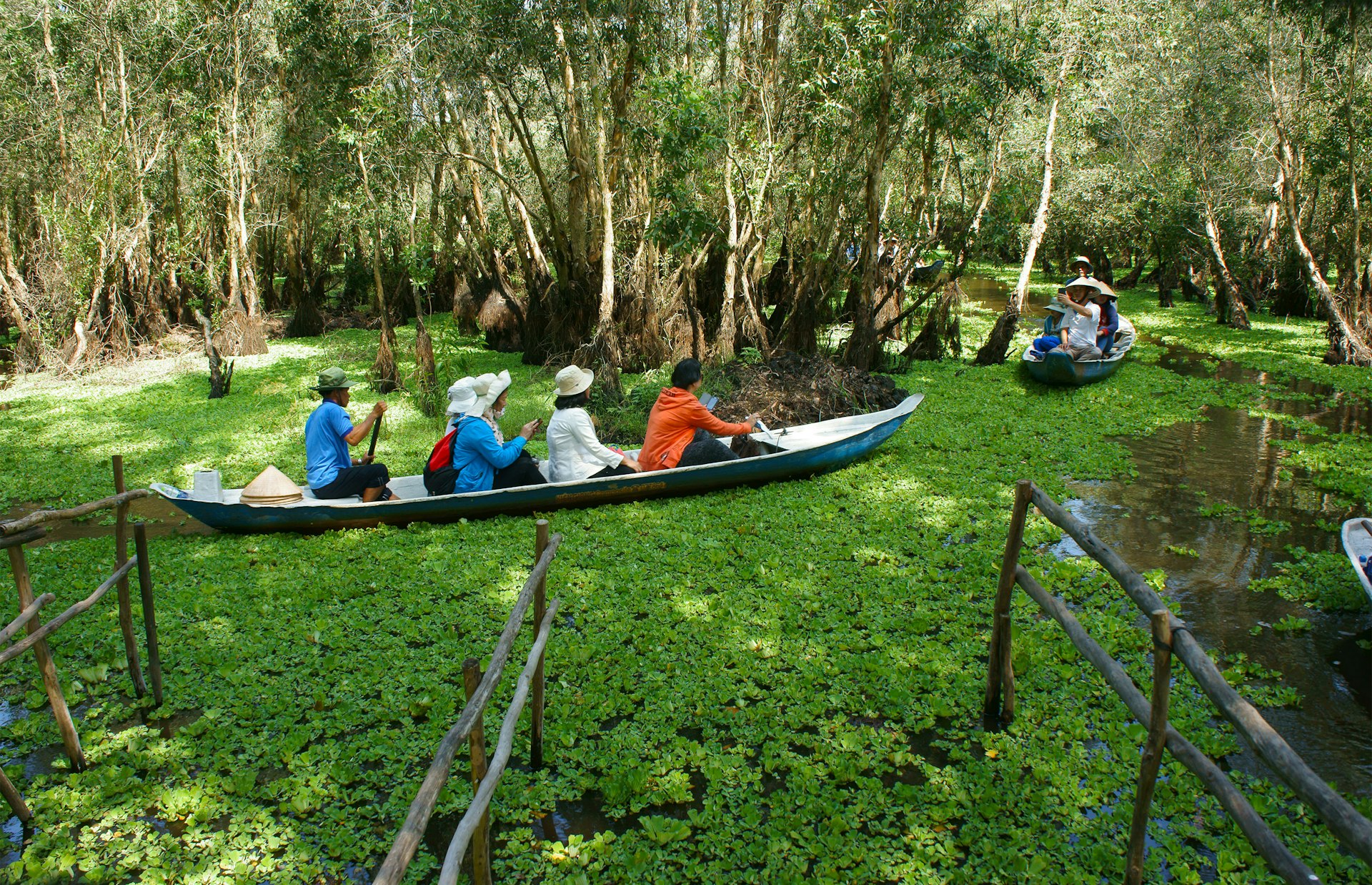 Take a tour of the tributaries of the Mekong Delta through the thick forest near Cai Be © xuanhuongho / Shutterstock
Take a tour of the tributaries of the Mekong Delta through the thick forest near Cai Be © xuanhuongho / Shutterstock
14. Float on the Mekong Delta
Breaking into the South China sea like an open hand, the mighty Mekong river ends the 4350km (2700 mile) journey it started in the Tibetan plateau to the south of Ho Chi Minh City. For centuries, the Mekong Delta has been Vietnam’s rice bowl, nurturing a network of sleepy towns and villages on stilts that use the river as their primary water artery for life and trade.
The best way to explore is obviously by taking to the waters, either by cruising overnight on the main channel between Cai Be and Can Tho or by paying the local fisher-folks to take you on the backwaters, where the smaller waterways become so narrow you may come face to face with a heron or two.
15. Ride through Ha Giang and the Dong Van Karst Plateau Unesco Global Geopark
Adored by bikers and cyclists alike, the 350km loop between Ha Giang and Dong Van is spectacular no matter how you tackle it — though peering through the windshield of a local minivan does tune down the majesty of the region’s single file of wavy limestone karsts, infinite river gorges, and misty peaks that separate Vietnam from China.
Planning tip: Don’t rush and take three to five days to bunk down at scenic homestays, visit the H’Mong King Palace and learn about the region’s former days as an opium trading post, and then stop at the 1500m (4921ft) high Ma Pi Leng Pass to take in some of Vietnam’s best scenery.



